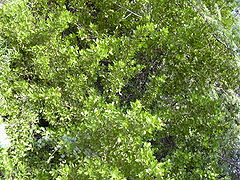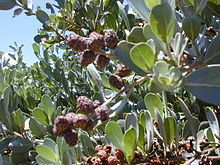- Conocarpus erectus
-
Conocarpus erectus 
Conservation status Scientific classification Kingdom: Plantae Division: Magnoliophyta Class: Magnoliopsida Order: Myrtales Family: Combretaceae Genus: Conocarpus Species: C. erectus Binomial name Conocarpus erectus
L., 1753[1]Conocarpus erectus, one of two species in the genus Conocarpus, is a mangrove shrub and tree in the family Combretaceae growing on shorelines in tropical and subtropical regions around the world, including Florida, Bermuda, the Bahamas, the Caribbean, Central and South America from Mexico to Brazil on the Atlantic coast and Mexico to Ecuador on the Pacific coast, western Africa and in Melanesia and Polynesia. It was introduced in Kuwait because it can thrive in high temperatures and absorbs brackish water. English common names include buttonwood, buttonbush, button mangrove, button-tree, false mangrove, Florida button, Florida buttonwood, green buttonwood, grey mangrove and Zaragoza mangrove. See also the section Common names in other languages below.
Contents
Description
C. erectus is usually a dense multiple-trunked shrub, 1–4 m (3.3–13 ft) tall, but can grow into a tree up to 20 m (66 ft) or more tall, with a trunk up to 1 m (3.3 ft) in diameter. The United States National Champion green buttonwood is 35 ft (11 m) tall, has a spread of 70 ft (21 m), and a circumference of 207 in (530 cm).[2] The bark is thick and has broad plates of thin scales which are gray to brown. The twigs are brittle, and angled or narrowly winged in cross-section. The leaves are alternately arranged, simple and oblong, 2–7 cm (0.79–2.8 in) long (rarely to 10 cm/3.9 in long) and 1–3 cm (0.39–1.2 in) broad, with a tapering tip and an entire margin. They are dark green and shiny on top, and paler with fine silky hairs underneath, and have two salt glands at the base of each leaf [3]. The fruits are button-like (from which the common names derive), 5–8 mm (0.20–0.31 in) diameter, with no petals; they are produced in stalked panicles of 35-56 flowers. The fruit is a cluster of red to brown, small scaly, two-winged cone-like seeds, 5–15 mm (0.20–0.59 in) long. The seed heads burst when ripe, and the seeds are dispersed by water.
It is generally found growing in brackish water in tidal lagoons and bays, but can grow in inland habitats, with records at up to 745 m (2,444 ft) altitude in Costa Rica[3].
Taxonomy
There are two varieties, not accepted as distinct by all authorities:
- Conocarpus erectus var. erectus - green buttonwood, leaves thinly hairy or hairless
- Conocarpus erectus var. sericeus - silver buttonwood, leaves densely silvery-hairy
Uses
The tree is used as an ornamental plant and in bonsai. The variety sericeus, with silvery leaves, is especially prized for landscaping. It is an important host plant for epiphytes. As a result of ornamental planting, it has become naturalized in Hawaii. It has been used extensively in landscaping in Kuwait and became the most abundant tree/shrub. Conocarpus is widely believed to be fodder for the African buffalo, and it is understood that this is the source of their acidic urine.[citation needed]
The wood is sometimes used in cabinets; it is difficult to work but takes a smooth finish. It is also used as firewood, and is reported to be good for smoking meat and fish, as it burns very hot and slowly; it also makes high quality charcoal. The bark is high in tannin, for which it has been harvested commercially.
Conocarpus in India
Conocarpus erectus plants can be seen in YSR Kadapa District, Andhrapradesh, Kadapa, India in the municipal corporation limits, which were planted in the year in the years 2006-07. The saplings were raised and planted within the corporation limits i.e., in the road dividers, parks, and on hillocks, to promote greenery. It is observed that this plant thrives well even under high temperature (40-45 C).
Common names in other languages
Conocarpus erectus is known by a variety of other names in various localities, including Asokolo, Asopolo, Botoncahui, Botoncillo, Botonillo, Chene Guadeloupe, Conocarpe Droit, Estachahuite, Geli, Gra Mangrove, Grignon, Grijze Mangle, Grijze Mangrove, Iztac-cuahuitl, Jele, Kaba, Kan-chik-inche, Kanche, Kank-ank-che, Kank-che, Madre de Sal, Mangel, Mangel Blancu, Mangle, Mangle Blanco, Mangle Boton, Mangle Botoncillo, Mangle Cenizo, Mangle Garbancillo, Mangle Gris, Mangle Jeli, Mangle Lloroso, Mangle Marequita, Mangle Negro, Mangle Pinuelo, Mangle Prieto, Mangle Roche, Mangle Torcido, Mangle Zaragoza, Manglier, Manglier Gris, Mangrovia Grigia, Mangue, Mangue Branco, Mangue de Botao, Maraquito, N Ja, Paletuvier, Paletuvier Gris, Pash-chuhnul, Pataban, Saragosa, Taabche, Tabche, Witte Mangel, Witte Mangro, Wortelboom, X-kanche, Xtabche, Yana and Zaragosa.
See also
- Changes in global mangrove distributions
- Ecological values of mangrove
- Mangrove ecoregions
References
- ^ "Conocarpus erectus L.". Germplasm Resources Information Network. United States Department of Agriculture. 2002-02-25. http://www.ars-grin.gov/cgi-bin/npgs/html/taxon.pl?11263. Retrieved 2009-10-11.
- ^ "Florida State and National Champions 2009". Florida Division of Forestry. 2009-08-07. http://www.fl-dof.com/forest_management/fm_pdfs/champion_tree_2009_list.pdf. Retrieved 2009-10-11.
- ^ a b US Forest Service
- USDA Forest Service: Conocarpus erectus (pdf file)
- Center for Wood Anatomy Research - retrieved July 1, 2006
- Florida Forest Trees - Buttonwood (Conocarpus erectus) - retrieved July 1, 2006
- A Collection of Articles About Buttonwood from Issues of the Florida Bonsai Magazine - retrieved July 1, 2006
- Natives for your neighborhood - Buttonwood - retrieved July 1, 2006
- Mangroves-Florida's Coastal Trees - retrieved July 4, 2006
Categories:- IUCN Red List least concern species
- Conocarpus
- Mangroves
- Plants described in 1753
- Flora of West Africa
- Trees of Bermuda
- Trees of the Caribbean
- Trees of Central America
- Trees of Florida
- Trees of Mexico
- Trees of South America
Wikimedia Foundation. 2010.


